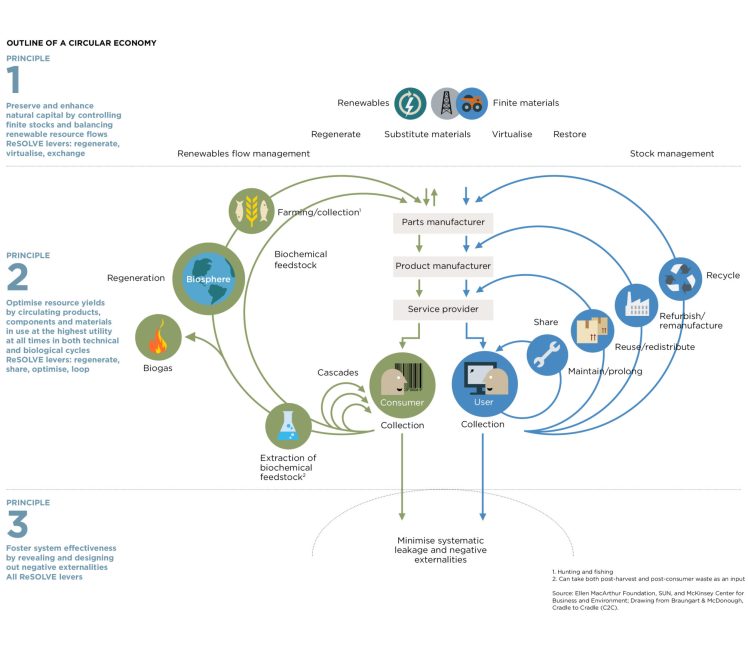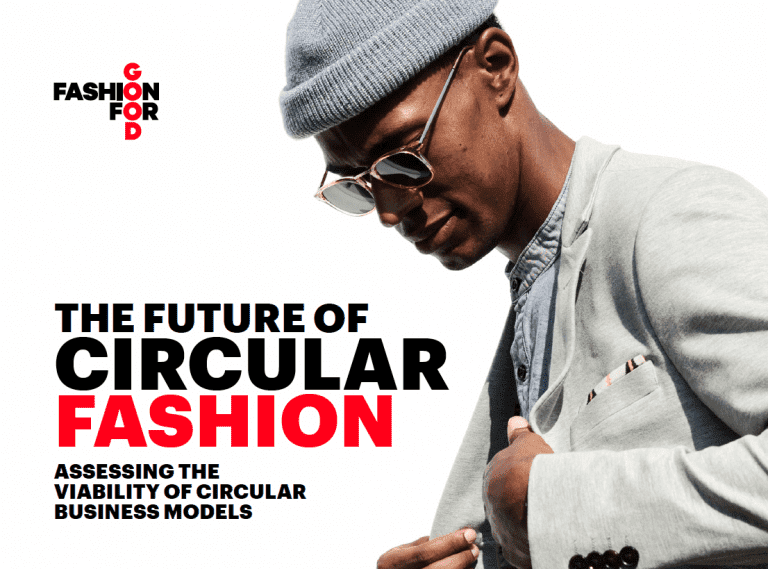The Concept of Circular Economy is the Inspiration for the Circular Fashion Initiative .In 2014,The Term Circular Fashion was Coined by two Individuals at Different Occasions ,The First one is Dr. Anna Brismar, Owner of Swedish Consultancy firm “Green Strategy.” The Other Person Who Termed the Phrase “Circular Fashion “is one of the H&M Staff at Stockholm .They first used the term Officially in a Presentation at the event “Almedalen Week” in the south of Sweden. Dr. Brismar Introduced the first Definition and Principle of Circular Fashion in Theoretical Basis in 2014. She Detailed the Concept of Circular Fashion in a Fashion show and talk Event at Central Stockholm, as guidance for involved brands in the Fashion show as well as for Individuals ( Origin of the Concept Circular Fashion,2015) 2014 was the year the Concept of Circular Economy Emerged and Sailed Strongly on a Political Agenda in Sweden and Europe.
Circular Fashion
As defined by Anna Brismar, the concept ‘circular fashion’ is based on the main principles of circular economy and sustainable development, and relates to the fashion industry in a wide sense, i.e. not only to fashion but also apparel, sportswear and outdoor wear. Garments as well as shoes and accessories are in focus. The sixteen key principles of circular fashion concern the entire life cycle of a product, from design and sourcing, to production, transportation, storage, marketing and sale, as well as the user phase and the product’s end of life. The concept was inspired by the notion of circular economy, primarily the theories presented on the Ellen MacArthur Foundation website. The following definition has been developed by Brismar and is the only existing definition to date (the last version updated in 2017)
What is Circular Fashion?
Circular fashion is…
Circular fashion is a system where our clothing and personal belongings are produced through a more considered model: where the production of an item and the end of its life are equally as important. This system considers materials and production thoughtfully, Emphasising the value of Utilising a product right to the end, then going one step further and repurposing it into something else. The focus is on the longevity and life cycle of our possessions, including designing out waste and pollution. Essentially, the ‘circular’ comes as a response to previous economic and societal models that have been ‘linear’ to date, and harmful on the planet along the way.
Circular fashion is a system where our clothing and personal belongings are produced through a more considered model: where the production of an item and the end of its life are equally as important.
Further to this, circular fashion comes from the collision and intersection of the ‘circular economy’ (a model that exchanges the typical cycle of make, use, dispose in favour of as much reusing and recycling as possible) with sustainable and ethical fashion. The development and evolution of these two areas ran parallel for some time within different sectors. This new category is a much needed addition to the fashion industry’s sustainability journey and progression, particularly as it brings stronger ambition and advocacy, as well as a commitment to investing in clothing that will last far longer than fast fashion counterparts.
Key points of circular fashion:
- Using less materials in producing individual items for increased recyclability
- Working to remove nonrecyclable and polluting materials from the supply chain
- Recapturing everything from garment off cuts to packaging for reuse
- Ensuring use and reuse for as long as possible including collection schemes and bringing the recycled materials back to a ‘good as new’ state
- Returning any unavoidable waste to nature safely
Origin of the concept ‘circular fashion’
The concept ‘circular fashion’ was first coined and used in spring 2014 by two actors, almost simultaneously and independently of each other. One of these was Anna Brismar, owner of the consultancy firm Green Strategy. Brismar coined the term circular fashion in June 2014 at an early project meeting, when planning for a sustainable fashion event in central Stockholm. (This event was hereafter named CIRCULAR FASHION – SHOW & TALK 2014.) As developer and manager of the CFST 2014 event, Brismar introduced the concept and main principles of circular fashion to all participating brands and panelists as a guiding framework in preparing for the event. Some of the more well-known Swedish brands showcased at the event were Filippa K, Houdini and Nudie Jeans. Panelists at the two panel debates were professionals working in the sustainable fashion field in Sweden at the time. The CFST 2014 event became an important catalyst for spreading the concept of circular fashion within the fashion industry, first in Sweden and soon across a wider audience in Europe and globally.
Another actor that was also first to use the term circular fashion was H&M, specifically its sustainability staff at the H&M’s headquarters in Stockholm. H&M used the term internally for the first time in spring 2014. In July 2014, H&M went out officially for the first time with the term, in its Swedish form (‘cirkulärt mode’), at a public seminar during “Almedalen week” on Gotland in the South of Sweden.
In short, 2014 was the year when the notion of circular economy sailed in strongly on the political agenda in Sweden and other European countries, and possibly elsewhere too. Apparently, the time was right for the two concepts of circular economy and sustainable fashion to merge – as circular fashion.
Circular Economy in Fashion
Millennials are driving companies to sustainable practices even if their business model is based on volume, low margins. New generations demand for sustainable products and a visible and transparent value chain: from “sheep to shop”, something that blockchain is already enabling. Another interesting trend to mention is nownership, or the end of ownership as repair and rental business models continue to evolve (e.g. Bag Romance, Haute Vault). Note that Rent The Runway was recently valued at $1 Billion (March 2019).
Sustainability goes beyond fashion and embraces other industries such as the Food and Beverages Industry. There is a growing concern over healthy, authenticity and provenance. A clear example is the declining consumption in sugary drinks in Western Countries. Are Millennials going to kill Coke?
Slow Fashion, Ethical Fashion, Upcycling, Vegan Fashion, Circular Fashion…

Meaningful Fashion Brands
Sustainable Fashion article commented on what brands are leading the “eco” trend and how they are achieving it. Other initiatives have been launched such as Make Fashion Circular, that brings together industry leaders including Burberry, Gap Inc., H&M, HSBC, NIKE Inc., PVH and Stella McCartney as core partners. Fortunately, there is a growing number of companies exploring circular fashion potentials.
What is Circular Economy and what is the impact in the Fashion Industry?
According to Ellen MacArthur Foundation, looking beyond the current take-make-waste extractive industrial model, a circular economy aims to redefine growth, focusing on positive society-wide benefits. It entails gradually decoupling economic activity from the consumption of finite resources, and designing waste out of the system. Underpinned by a transition to renewable energy sources, the circular model builds economic, natural, and social capital. It is based on three principles:
- Design out waste and pollution
- Keep products and materials in use
- Regenerate natural systems

Circular Economy System Diagram ©Ellen MacArthur Foundation
Another interesting definition of Circular Fashion is the following: “Clothes, shoes or accessories that are designed, sourced, produced and provided with the intention to be used and circulate responsibly and effectively in society for as long as possible in their most valuable form, and hereafter return safely to the biosphere when no longer of human use”. (Dr. Anna Brismar, 2017, circularfashion.com)
WHAT IS CIRCULAR DESIGN?
In 2014, Anna Brismar, a global expert in circularity and sustainability coined the term ‘circular fashion’, and defined it later as “Clothes, shoes or accessories that are designed, sourced, produced and provided with the intention to be used and circulate responsibly (towards humans, living beings and the planet) and effectively in society for as long as possible, in their most valuable form, and hereafter return safely to the biosphere when no longer of human use.”
Circular fashion is a concept aimed to bring relief to the planet and the environment by reducing the waste that threatens to choke it today and increase the lifespan and reusability of the products created. The concept can be applied across the life cycle of a product – starting from the sourcing of fibre and yarn to its design, production, transportation, marketing, sale, all the way to its human use phase and the condition it exists in its life cycle post-use. Circular fashion is aimed at improving resource and energy efficiency in terms of design and production, reducing the waste generated throughout the life cycle and the environmental impact through the entire production process. Circular fashion ensures that the way the product is created leads to a closed loop system across the product’s lifecycle. Rooted in the idea of a ‘circular economy’, circular fashion is pushing the industry from its current ‘take-make-dispose’ approach to one that creates positive and lasting impact environmentally, socially, and economically through a reuse – repurpose – reduce – recycle approach.
Circular economy
A circular economy (also referred to as “circularity”[2]) is an economic system aimed at eliminating waste and the continual use of resources. Circular systems employ reuse, sharing, repair, refurbishment, remanufacturing and recycling to create a closed-loop system, minimising the use of resource inputs and the creation of waste, pollution and carbon emissions.[3] The circular economy aims to keep products, equipment and infrastructure[4] in use for longer, thus improving the productivity of these resources. Waste materials and energy should become input for other processes: either a component or recovered resource for another industrial process or as regenerative resources for nature (e.g., compost). This regenerative approach is in contrast to the traditional linear economy, which has a “take, make, dispose” model of production.
Reference-. Textile Recycling in The UK I: Black 5.(ED) The Sustainable Fashion Hand Book Thames & Hudson London




